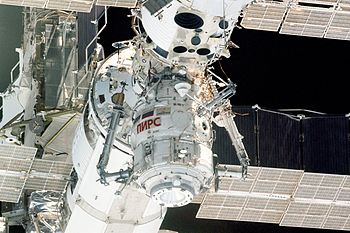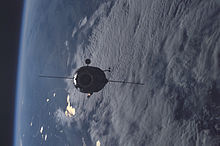- Pirs (ISS module)
-
The Pirs docking compartment is a Russian module of the International Space Station (ISS). Pirs (Russian: Пирс, meaning "pier") -- also called "Stikovochny Otsek 1" or "SO-1" (Russian: Стыковочный отсек, "docking module", or DC-1 (docking compartment) -- is one of the two Russian docking compartments originally planned for the ISS. Pirs was launched in August 2001. It provides the ISS with additional docking ports, and allows egress and ingress for spacewalks by cosmonauts using Russian Orlan space suits. When the Russian segment of the ISS was redesigned in 2001, the new design did not include the SO-2, and its construction was canceled.[1] The SO-2 module now forms the basis for the Poisk module.
Contents
Construction and design
The Russian docking compartment was manufactured by RKK Energia. The Docking Compartment is similar to the Mir Docking Module used on the Mir space station. It provides docking ports for the Soyuz-TMA and Progress-M spacecraft. It also has two airlocks to accommodate spacewalks by cosmonauts wearing Russian Orlan-M spacesuits.
Launch in 2001
The 3,580-kilogram Pirs Docking Compartment is attached to the nadir (bottom, Earth-facing) port of the Zvezda service module. It docked to the International Space Station on September 16, 2001, and was configured during three spacewalks by the Expedition 3 crew. Two Strela cargo cranes were later added by the STS-96 and STS-101 missions, carried up on Integrated Cargo Carriers and installed during EVAs.
Pirs was launched on September 14, 2001, as ISS Assembly Mission 4R, on a Russian Soyuz-U rocket, using a modified Progress spacecraft, Progress M-SO1, as an upper stage. The Docking Compartment has two primary functions. It serves as a docking port for the docking of transport and cargo vehicles to the space station, and as an airlock for the performance of spacewalks by two station crewmembers using Russian Orlan spacesuits.
In addition, the Docking Compartment can transport fuel from the fuel tanks of a docked Progress resupply vehicle to either the Zvezda Service Module Integrated Propulsion System or the Zarya Functional Cargo Block. It can also transfer propellant from Zvezda and Zarya to the propulsion system of docked vehicles—Soyuz and Progress. The docking compartment's planned lifetime as part of the station was five years.
Future
Pirs is scheduled to be detached from the nadir (bottom) port of the Zvezda module to make room for the Russian Multipurpose Laboratory Module which is scheduled for launch in December 2011.[2] It would then be destroyed during atmospheric re-entry and become the first ISS module to be decommissioned.
Airlock specifications
- Length: 4.91 metres (16.1 ft)
- Diameter: 2.55 metres (8 ft 4 in)
- Weight: 3,580 kilograms (7,900 lb)
- Volume: 13 cubic metres (460 cu ft)
Gallery
References
- ^ Anatoly Zak. "Docking Compartment of the Russian segment of the ISS". http://www.russianspaceweb.com/iss_dc.html.
- ^ NASA (2008). "Consolidated Launch Manifest". NASA. http://www.nasa.gov/mission_pages/station/structure/iss_manifest.html. Retrieved July 8, 2008.
External links
- "Pirs Docking Compartment". NASA. http://www.nasa.gov/mission_pages/station/structure/elements/pirs.html.
Components of the International Space Station Overview Assembly · US Orbital Segment · Russian Orbital Segment · Expeditions · Spacewalks · ISS Program · Scientific Research · Major Incidents
Major components
in orbitZarya (Functional Cargo Block) · Zvezda (Service Module) · Unity (Node 1) · Harmony (Node 2) · Tranquility (Node 3) · Destiny (Laboratory) · Columbus (Laboratory) · Kibō (PM, ELM-PS, EF) · Quest (Airlock) · Pirs (Airlock / Docking Module) · Rassvet (MRM 1) · Poisk (MRM 2) · Leonardo (PMM) · Cupola · Integrated Truss Structure (ITS)Subsystems
in orbitFlight-ready hardware
with no launch planScheduled for launch
by ProtonProposed module Cancelled Support vehicles Current: Soyuz · Progress · Automated Transfer Vehicle (ATV) · H-II Transfer Vehicle (HTV)
Future: Dragon · Cygnus · Orion · Rus · CST-100
Former: Space ShuttleMission control centers ← 2000 · Orbital launches in 2001 · 2002 → Shenzhou 2 | Turksat 2A | Progress M1-5 | USA-156 | Sicral 1 · Skynet 4F | STS-98 (Destiny) | Odin | Progress M-44 | USA-157 | STS-102 (Leonardo MPLM) | Eurobird 1 · BSat-2A | XM-2 | Ekran-M #18L | Mars Odyssey | GSAT-1 | STS-100 (Raffaello MPLM) | Soyuz TM-32 | XM-1 | PAS-10 | USA-158 | Progress M1-6 | Kosmos 2377 | Kosmos 2378 | Intelsat 901 | Astra 2C | ICO F2 | MAP | STS-104 (Quest) | Artemis · BSat-2B | Molniya-3K #11 | GOES 12 | Koronas-F | USA-159 | Genesis | STS-105 (Leonardo MPLM · Simplesat) | Progress M-45 | Kosmos 2379 | VEP-2 · LRE | Intelsat 902 | USA-160 | Progress M-SO1 (Pirs) | OrbView-4 · QuickTOMS · SBD · Odyssey | Atlantic Bird 2 | Starshine 3 · PICOSat · PCSat · SAPPHIRE | USA-161 | Globus #14L | USA-162 | QuickBird-2 | Soyuz TM-33 | TES · PROBA · BIRD-1 | Molniya-3 #64 | Progress M1-7 (Kolibri 2000) | DirecTV-4S | Kosmos 2380 · Kosmos 2381 · Kosmos 2382 | STS-108 (Raffaello MPLM · Starshine 2 | Jason-1 · TIMED | Meteor-3M #1 · Kompass · Badr-B · Maroc-Tubsat · Reflektor | Kosmos 2383 | Kosmos 2384 · Kosmos 2385 · Kosmos 2386 · Gonets-D1 #10 · Gonets-D1 #11 · Gonets-D1 #12Payloads are separated by bullets ( · ), launches by pipes ( | ). Manned flights are indicated in bold text. Uncatalogued launch failures are listed in italics. Payloads deployed from other spacecraft are denoted in brackets.Categories:- Components of the International Space Station
- Russian components of the International Space Station
- 2001 in spaceflight
Wikimedia Foundation. 2010.





